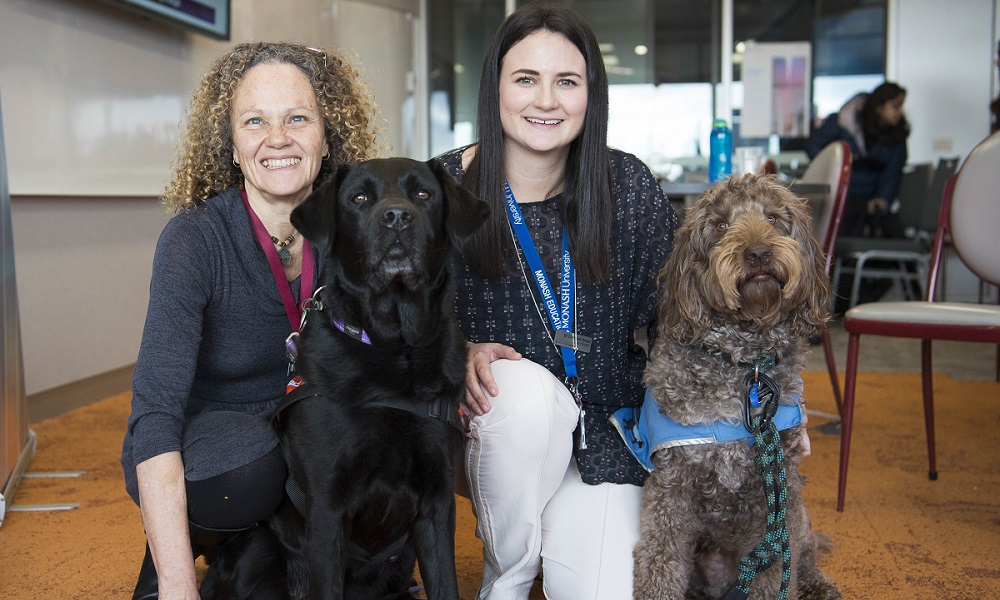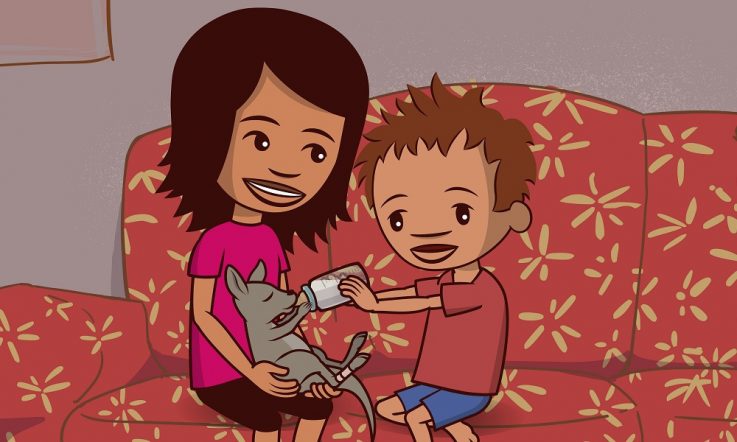This podcast from Teacher magazine is supported by QSuper. QSuper looks after the retirement savings of more than 110 000 Queensland teachers and Department of Education staff. With QSuper you get comparable long-term returns with fewer ups and downs, so you can feel confident your future is in safe hands. Visit www.qsuper.com.au for more information.
Hello and thank you for downloading this podcast from Teacher magazine – I'm Rebecca Vukovic.
Can therapy dogs decrease anxiety and stress in students, and improve school attendance? These are just some of the questions Monash University academics are trying to answer as they push for more research in this area. In today's podcast I'm joined by Dr Linda Henderson and Dr Christine Grove from the Faculty of Education at Monash University.
Both researchers have trained their own therapy dogs – Daymon the black Labrador and Bronson the Labradoodle, who you might hear moving around in the background of this episode. Dr Henderson is a Senior Lecturer and a former teacher, and she raised Daymon from a puppy. He initially worked as a guide dog before retiring and retraining as a therapy dog. Dr Grove is a Lecturer at Monash and also an educational and developmental psychologist. She has been using Bronson in both educational and clinical settings to help children to overcome their fears. To kick off this episode, I start by asking the researchers to run me through the benefits of using therapy dogs in a school setting.
Linda Henderson: Okay, so some of the benefits of therapy dogs in a school setting include things like allowing children to increase their interpersonal skills in terms of learning how to interact with a dog and that can therefore translate into how they enact their relationships with their peers. Also it can reduce their anxiety around learning tasks that they may find actually stressful, so it can actually allow them to engage in such things as reading and writing, with the aid of a dog to help reduce their stress levels. So it may be just having a dog next to them as they engage in reading and they can pat the dog during that task and that actually reduces stress levels … well, we hope. I guess we'll move onto that.
Christine Grove: And so some really good things around confidence too. We know kids with low confidence, having a dog in the room, just their presence alone can increase engagement and we've got a lot of anecdotal evidence around kids more likely coming to school if there's a dog present. And so you can see some really cool online stories about schools where they have a therapy dog, and how it's addressed attendance rates, in particularly at-risk areas. So, while we have some research around this, we can't yet really link it to literacy outcomes and so we need to do some more research and identify some of these key ingredients and things that are happening to then say whether there is an impact on learning. And we kind of also want to gather some data around attendance too. So, in a school that has a therapy dog, what are the actual statistics on that?
Rebecca Vukovic: Yep, because that's what I want to talk a little more about – the research or the lack thereof of research. Could you talk a little more about that?
LH: What we know? We know there's lots of anecdotal evidence in terms of the use of therapy dogs, however the solid research … so when I was saying ‘it can actually reduce stress' – that was all anecdotal. So there is some evidence to show some of the chemical changes that take place in terms of interaction with a dog, but there isn't solid evidence to actually show that having a dog reduces … that direct relationship isn't yet known. So we know anecdotally that there's an impact on a child's wellbeing which therefore can then impact on a child's learning outcomes, but we actually don't have the solid evidence to actually show that this is going on when we use a therapy dog. And so that is where we are needing the research at the moment to be really focused on. It's really critical.
RV: And so I was also wondering, when you take your therapy dogs into a school setting, what kinds of things happen? So are the children allowed to pet the dogs or do they read to the dogs?
LH: So what Daymon does he reads with one child. Children are selected by their teachers specifically to read with him, and a story dog will go in with a volunteer. The child is selected by the teacher. The volunteer doesn't know why the child has been selected, so personal information as to why that child has been selected isn't passed on in terms of passing personal information on – other than they will benefit from reading with the dog. So it's a one-on-one situation with parent permission to engage with Daymon. So it's not just a free-for-all. Can other children pat him? Yes, I do allow them, but I also teach them that he needs to sit first and you have to ask and you can't just all run up. There's lots of teaching that goes on in terms of actually thinking about that as well.
CG: So with Bronson, I use him quite therapeutically in the sense that he might engage with vulnerable kids that might be on the spectrum and might need to learn some social skills in certain situations. So we use him in that way. And absolutely, when he comes into a school kids are meant to engage with him. So he's not a service dog, meaning that if he was a service dog, you can't go up to him and there's a lot of legalities around that with service dogs. So with Bronson, absolutely – kids are meant to touch him and say hi and give him a big rub, which is what happens. And so we know that if he's around, kids are more likely to come to therapy or come to our wellbeing area. That's what he does.
RV: And Christine you mentioned specifically in your presentation about Bronson having epilepsy and how this helps with your interactions with students who have epilepsy. Could you tell me a bit more about that?
CG: Absolutely, and so Bronson was diagnosed around two-years-old and it happened in the middle of the night. He had a really big seizure and we actually thought he had died because it was quite a full-on first seizure. And we thought it was developmental or we weren't sure, and so that experience was really full-on and really interesting. And then we've been able to talk about Bronson's experience in that – and having to go to get MRIs and doing a lot of tests to identify and then be on ongoing, regular medication and regular visits and blood tests now – with kids who have chronic health conditions. And so how I might use Bronson is ‘well, actually Bronson totally knows what that's like! He has also had to go through an MRI and he didn't like it, he really made a big fuss. How do you go going through an MRI?'
And it normalises that tough conversation that you can have with kids who ordinarily wouldn't share unless they thought someone would understand what that's like. And we know kids with chronic health conditions don't share with their peers that they're going through that, nor do they really want to because their peers don't necessarily know how to respond in the best ways. And so Bronson gives that non-judgemental, unconditional, positive response to that situation. And then we can even talk around the medication every day and how keeping Bronson well is tough and part of his journey. That's part of kids taking that responsibility too for their health, which is a really tough thing to do. So Bronson is empowering in that sense. One kid described it to me as, ‘Oh Bronson is damaged goods like me'. And it was just a really surreal moment that they could connect them in that way and we could talk about ‘well, what do you mean by that? Because I don't see Bronson in that way, in fact I haven't thought of him differently. In fact, I think Bronson is pretty resilient and a strong dog to come and get through this'. So we talk in that strength-based way.
RV: Really powerful. And I know that we've talked about the benefits but despite all of them, some schools still choose not to have therapy dog programs in their schools. So I was hoping you could talk a bit more about the perceived risks of taking part in therapy dog programs?
LH: There are schools that don't want to have therapy dogs. There are people who have concerns around therapy dogs. Some of the most common concerns are around allergies. So yes, dogs have hair, dogs have fur and allergies are an issue, so we can't rule that out. Yet, we do have dogs like Bronson who is allergy free – but even that, some people say ‘is there even such a thing as a truly allergy free dog?' So there are even questions around that sense of allergy free dog. So, we know that there are the allergy issues and they are legitimate issues.
But then there are also other concerns around such things as safety. And of course schools are concerned with safety and that's totally understandable. They are ultimately responsible for the safety of their children. So there are lots of concerns around: Will the dog bite? Will the dog hurt the children? All those sorts of concerns, and a lot of that comes from not understanding exactly who a therapy dog is in terms of their selection, their training, their need to pass strict criteria in order to become a therapy dog and what they have gone through in order to make sure that they will react appropriately if they are hurt by a child, or if a child happens to sit on top of him or whatever, that we know how Daymon is going to react. So there's those sorts of concerns – which until there's a broader education of the public, I guess, and also more solid research that actually says, ‘look, this is the situation, this is who these dogs are, they're not just any dog, they are a very special dog' – and we also know that because they are so special they can produce these benefits. So that's what we're really needing to get at to dispel those myths.
CG: …It's important to acknowledge that there will be anxieties around therapy dogs in schools and we don't want to shut down those conversations, they're important to have so that we can challenge misconceptions about this space. Because when our dogs come in with us, they're not running around, jumping on people, they're not barking. They're really well behaved and we trust our dogs and know that if we need to leave them in a space and put them in a drop for a period of time, they will absolutely still be in that spot when we get back.
So there's a lot of training and evidence base that goes into creating a therapy dog. It doesn't just happen overnight and it isn't just like bringing your dog to school – there are objectives behind it, goals behind why that dog might be there and that's important to consider when we address some of these perceived risks.
LH: I think even I just had someone ask me a question about ‘is it fair for the dog?'. Even that is an interesting question in terms of … so the question was around ‘how often does he work?' And all those sorts of things and it's like, well actually he has time off … and he will go home and I will take his coat off and he will have a mad run around the background and that's him letting off.
As owners we are very aware of our dogs and their needs, so it's also our responsibility to look after our dogs' wellbeing as well. So, there are lots of concerns that are still out there.
RV: And so then finally, for schools looking to introduce a therapy dog program in their setting, what are some things they need to consider or do you have any advice for them for getting started?
LH: I think first of all it depends on the context and what they're looking for. So it's looking at doing a needs sort of assessment. What is it they're looking for to begin with? So I want a therapy dog but, okay, why? What is it that you're wanting to address? What in your wellbeing program are you actually wanting to address? So it's actually about addressing it from that perspective rather than just going, ‘oh it sounds good'. Because, they may not know actually what it is they're going to use that therapy dog for and what benefits are going to therefore flow out of that. So it has to be a well thought out decision and there has to be reasons why they're going to do it and therefore it also means there has to be a full commitment to the program. [It needs to be seen] within their overall wellbeing policy, not just something that happens on the side. So it really needs to be fully incorporated into their programs.
I think a school should make contact with a reputable organisation, other than us as well. But if they're going to think about it they need to think carefully about who they're making contact with first of all, and then to work through those processes in terms of thinking about: What am I wanting it for? What are the aims that I'm wanting to get out of it? And to have a real clear plan, and that would help us with our research.
CG: And building on that, Linda is right. You don't want to give the idea that therapy dogs can fix everything and it's a magic wand, because it's not. It needs to come into a school with a need and we do have some schools that I know right now in my mind that would greatly benefit from a whole-school approach where there is a therapy dog part of that process. But it needs to come from a needs-based assessment as part of the wellbeing policy and included and written into their inclusion framework.
LH: And well communicated to parents as well. So, there needs to be acceptance across the community body in terms of accepting what they're wanting to implement. I'm even aware of cultural issues with dogs, so you have to take even that into consideration … you know there are certain cultures that consider dogs to be dirty and so you need to be aware of that and work through that with various families. So there may even be those issues that a school has to work through before they begin to think about getting a therapy dog.
RV: Fantastic, well Dr Linda Henderson and Dr Christine Grove, and of course Daymon and Bronson as well, thank you for sharing your insights with Teacher magazine.
LH: No worries.
CG: Thanks for having us.
That's all for this episode – to keep listening or to download all of our podcasts for free, whether it's from our series on School Improvement, Behaviour Management, Global Education, Teaching Methods, Action Research or The Research Files, just visit acer.ac/teacheritunes or soundcloud.com/teacher-ACER. The full transcript of this podcast is available at teachermagazine.com.au. That's where you'll also find the latest articles, videos and infographics for free.
This podcast from Teacher magazine is supported by QSuper. Your retirement is something you save for your entire working life, and it's important to feel confident your money is in safe hands. With QSuper you get comparable long-term returns with less ups and downs. After all, it's the long-term performance of your savings that's important. Visit www.qsuper.com.au for more information.
Have you considered using a therapy dog in your school setting? What would be some of the perceived benefits of using a therapy dog with your students? What are some of the risks?



